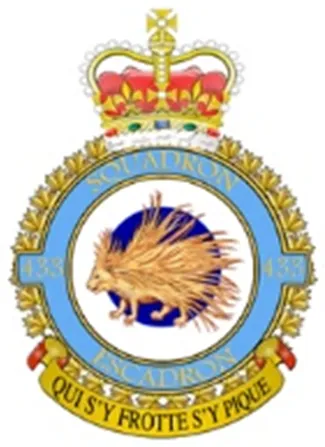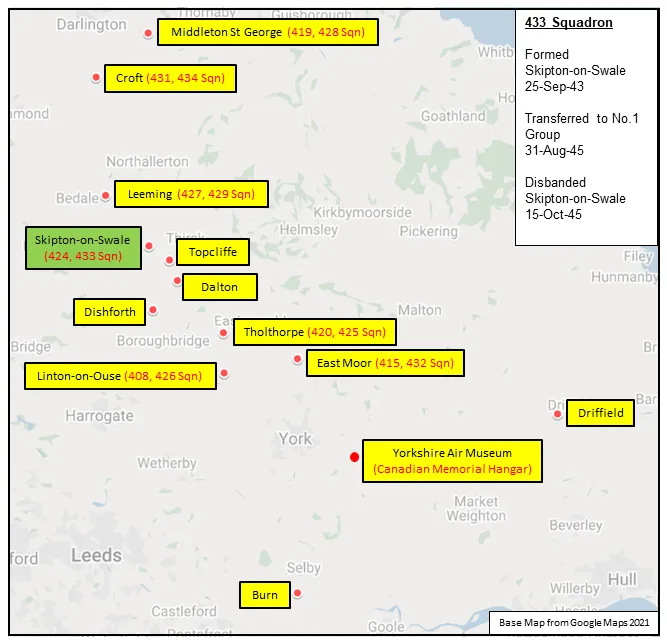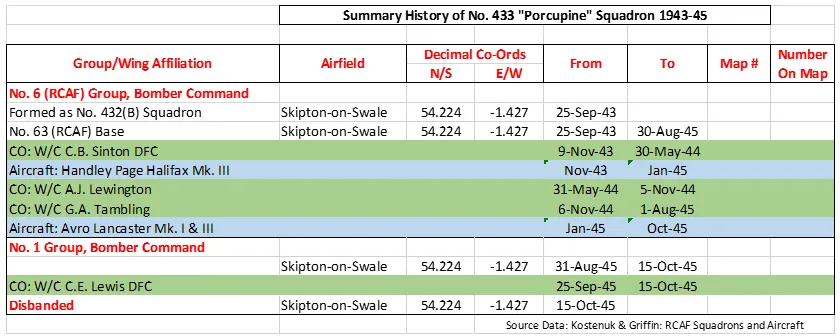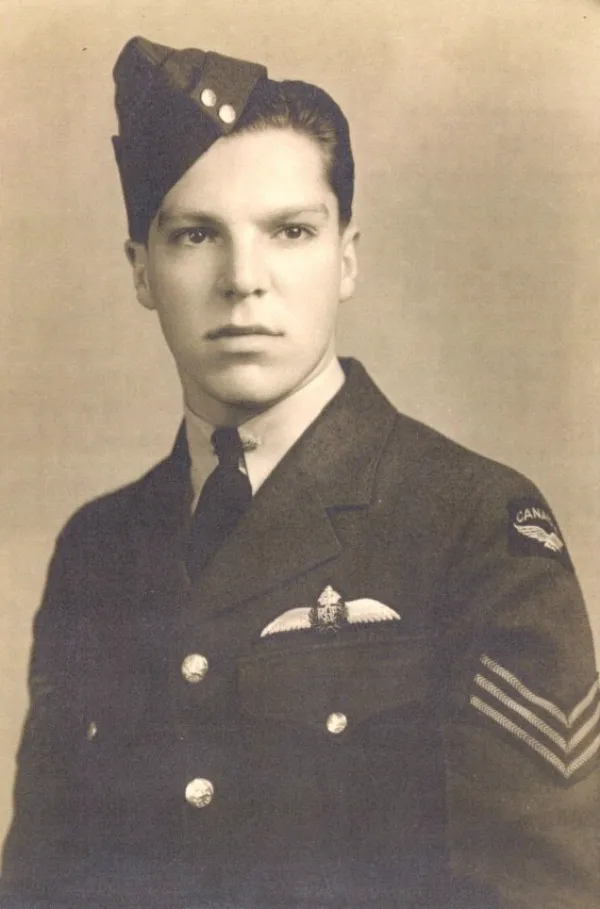433 (B) Sqn Qui S'y Frotte S'y Pique ("Porcupine")
History of the Squadron during World War II (Aircraft: Halifax III, Lancaster I, III)

433 Squadron was the 14th and last bomber squadron of the RCAF to be formed overseas in WWII. It was formed in September 1943 as a unit of No 6 (RCAF) Group of Bomber Command. It flew from Skipton-on-Swale, Yorkshire, UK  for the whole of its operational career. With the squadron code letters BM, it originally flew Handley Page Halifax Mk III heavy bombers on its bombing missions, but these were replaced by Lancaster Mks I and III in January 1945. After the cessation of hostilities the squadron was retained in England as a unit of No 1 Group RAF from August 1945, and took part in the airlift of PoWs back to England (Operation EXODUS) and the bringing back of troops from Italy (Operation DODGE). The squadron was disbanded at Skipton in October 1945.
for the whole of its operational career. With the squadron code letters BM, it originally flew Handley Page Halifax Mk III heavy bombers on its bombing missions, but these were replaced by Lancaster Mks I and III in January 1945. After the cessation of hostilities the squadron was retained in England as a unit of No 1 Group RAF from August 1945, and took part in the airlift of PoWs back to England (Operation EXODUS) and the bringing back of troops from Italy (Operation DODGE). The squadron was disbanded at Skipton in October 1945.
In the course of its operations, the squadron flew 209 missions involving 2316 individual sorties for the loss of 38 aircraft , dropping 7486 tons. Awards to crew members included 132 DFCs, 2 Bars to DFC, 9 DFMs, 1 BEM, 14 MiDs and 1 Air Medal (USA). Battle Honours were: English Channel and North Sea 1944-45, Baltic 1944-45, Fortress Europe 1944, France and Germany 1944-45, Biscay Ports 1944, Ruhr 1944-45, Berlin 1944, German Ports 1944-45, Normandy 1944, Rhine, Biscay 1944.Wikipedia, Kostenuk and Griffin
Squadron History (Bomber Command Museum PDF)
Maps for Movements of 433 Squadron 1943-45

433 Squadron History Summary 1943-45

History of the Squadron Post-WWII (Aircraft: Canuck, Freedom Fighter, Hornet)
The squadron re-formed as an All-Weather (Fighter) unit at CFB Cold Lake, Alberta  , on 15 November 1954, as one of nine CF-100 squadrons to defend Canadian airspace. It moved to CFB North Bay, Ontario
, on 15 November 1954, as one of nine CF-100 squadrons to defend Canadian airspace. It moved to CFB North Bay, Ontario  , in October 1955, the squadron flew CF-100 Canuck aircraft on North American air defence. However, in 1961 the Government decided to reduce the number of CF-100 squadrons from nine to five and 433 Squadron was dissolved for a second time on July 31st, 1961.
, in October 1955, the squadron flew CF-100 Canuck aircraft on North American air defence. However, in 1961 the Government decided to reduce the number of CF-100 squadrons from nine to five and 433 Squadron was dissolved for a second time on July 31st, 1961.
Reformed post-unification on 15 August 1968, as No. 433 Escadrille tactique de combat it was a French language squadron of Mobile Command based at CFB Bagotville, Quebec  . The squadron flew the CF-5 Freedom Fighter in the tactical and reconnaissance role until it converted to the CF-188 Hornet fighter jets in 1984. The squadron was deactivated in 2005, and its assets and personnel amalgamated into 425 Tactical Fighter Squadron. Besides being originally designated as one of two bases of NATO's Rapid Reaction Force, the 433 Squadron was entrusted a NORAD role in December 1988. The 433 Squadron members in Bagotville played an important role in the Gulf War conflicts, better known under the names Operation FRICTION in 1991 and Operation ECHO in 1999. By September 2001, the Squadron was actively participating with NORAD in the fight against terrorism through Operation NOBLE EAGLE. On July 14th, 2005, the standards of the Squadron were once again laid aside almost 62 years after its initial formation. .Wikipedia
. The squadron flew the CF-5 Freedom Fighter in the tactical and reconnaissance role until it converted to the CF-188 Hornet fighter jets in 1984. The squadron was deactivated in 2005, and its assets and personnel amalgamated into 425 Tactical Fighter Squadron. Besides being originally designated as one of two bases of NATO's Rapid Reaction Force, the 433 Squadron was entrusted a NORAD role in December 1988. The 433 Squadron members in Bagotville played an important role in the Gulf War conflicts, better known under the names Operation FRICTION in 1991 and Operation ECHO in 1999. By September 2001, the Squadron was actively participating with NORAD in the fight against terrorism through Operation NOBLE EAGLE. On July 14th, 2005, the standards of the Squadron were once again laid aside almost 62 years after its initial formation. .Wikipedia
The squadron was reactivated on 9 June 2015, and celebrated its 75th anniversary on 15 September 2018.




 Canadian Virtual War Memorial
Canadian Virtual War Memorial Library and Archives Canada Service Files (may not exist)
Library and Archives Canada Service Files (may not exist)